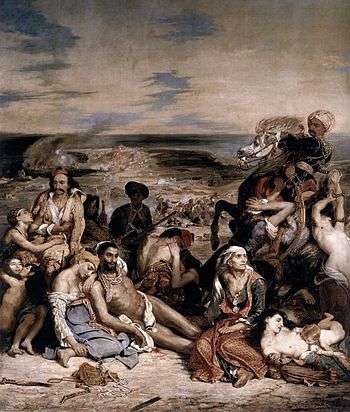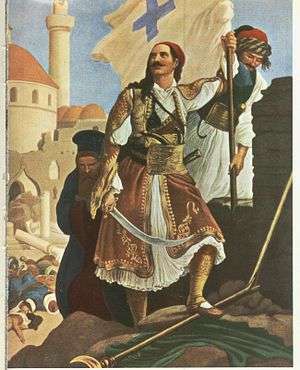Philhellenism

Philhellenism ("the love of Greek culture") and philhellene ("the admirer of Greeks and everything Greek"), from the Greek φίλος philos "friend, lover" and ἑλληνισμός hellenism "Greek", was an intellectual fashion prominent mostly at the turn of the 19th century. It contributed to the sentiments that led Europeans such as Lord Byron or Charles Nicolas Fabvier to advocate for Greek independence from the Ottoman Empire.
The later 19th-century European Philhellenism was largely to be found among the Classicists.
Philhellenes in antiquity
In antiquity, the term 'philhellene' (Greek: φιλέλλην, from φίλος - philos, "dear one, friend" + Έλλην - Hellen, "Greek"[1]) was used to describe both non-Greeks who were fond of Greek culture and Greeks who patriotically upheld their culture. The Liddell-Scott Greek-English Lexicon defines 'philhellen' as "fond of the Hellenes, mostly of foreign princes, as Amasis; of Parthian kings[...]; also of Hellenic tyrants, as Jason of Pherae and generally of Hellenic (Greek) patriots.[2]
Some examples:
- Evagoras of Cyprus[3] and Philip II were both called "philhellenes" by Isocrates[4]
- The early rulers of the Parthian Empire, merging Iranian and Greek culture described themselves as philhellenes
Roman philhellenes
The literate upper classes of Rome were increasingly Hellenized in their culture during the 3rd century BC.[5]
Among Romans the career of Titus Quinctius Flamininus (died 174 BC), who appeared at the Isthmian Games in Corinth in 196 BC and proclaimed the freedom of the Greek states, was fluent in Greek, stood out, according to Livy, as a great admirer of Greek culture; the Greeks hailed him as their liberator.[6] There were however, some Romans during the late Republic, who were distinctly anti-Greek, resenting the increasing influence of Greek culture on Roman life, an example being the Roman Censor, Cato the Elder and also Cato the Younger who lived during the "Greek invasion" of Rome but towards the later years of his life he eventually became a philhellene after his stay in Rhodes.
The lyric poet Quintus Horatius Flaccus was another philhellene. He is notable for his words, "Graecia capta ferum victorem cepit et artis intulit agresti Latio" (Conquered Greece took captive her savage conqueror and brought her arts into rustic Latium), meaning that after the conquest of Greece the defeated Greeks created a cultural hegemony over the Romans.
Roman emperors known for their philhellenism include Nero, Hadrian, Marcus Aurelius and Julian the Apostate.
Modern times
In the period of political reaction and repression after the fall of Napoleon, when the liberal-minded, educated and prosperous middle and upper classes of European societies found the romantic revolutionary ideals of 1789–92 repressed by the restoration of old regimes at home, the idea of the re-creation of a Greek state on the very territories that were sanctified by their view of Antiquity—which was reflected even in the furnishings of their own parlors and the contents of their bookcases—offered an ideal, set at a romantic distance. Under these conditions, the Greek uprising constituted a source of inspiration and expectations that could never actually be fulfilled, disappointing what Paul Cartledge called "the Victorian self-identification with the Glory that was Greece".[7]
Another popular subject of interest in Greek culture at the turn of the 19th century was the shadowy Scythian philosopher Anacharsis, who lived in the 6th century BCE. The new prominence of Anacharsis was sparked by Jean-Jacques Barthélemy's fanciful Travels of Anacharsis the Younger in Greece (1788), a learned imaginary travel journal, one of the first historical novels, which a modern scholar has called "the encyclopedia of the new cult of the antique" in the late 18th century. It had a high impact on the growth of philhellenism in France: the book went through many editions, was reprinted in the United States and was translated into German and other languages. It later inspired European sympathy for the Greek War of Independence and spawned sequels and imitations throughout the 19th century.
In German culture the first phase of philhellenism can be traced in the careers and writings of Johann Joachim Winckelmann, one of the inventors of art history, Friedrich August Wolf, who inaugurated modern Homeric scholarship with his Prolegomena ad Homerum (1795) and the enlightened bureaucrat Wilhelm von Humboldt. In the German states, the private obsession with ancient Greece took public forms, institutionalizing an elite philhellene ethos through the Gymnasium, to revitalize German education at home, and providing on two occasions high-minded philhellene German princes ignorant of modern-day Greek realities, to be Greek sovereigns.[8]
During the later 19th century the new studies of archaeology and anthropology began to offer a quite separate view of ancient Greece, which had previously been experienced at second-hand only through Greek literature, Greek sculpture and architecture.[9] 20th century heirs of the 19th-century view of an unchanging, immortal quality of "Greekness" are typified in J.C. Lawson's Modern Greek Folklore and Ancient Greek Religion (1910) or R. and E. Blum's The Dangerous Hour: The lore of crisis and mystery in rural Greece (1970); according to the Classicist Paul Cartledge, they "represent this ideological construction of Greekness as an essence, a Classicizing essence to be sure, impervious to such historic changes as that from paganism to Orthodox Christianity, or from subsistence peasant agriculture to more or less internationally market-driven capitalist farming."[10]
The Philhellenic movement led to the introduction of Classics or Classical studies as a key element in education, introduced in the Gymnasien in Prussia. In England the main proponent of Classics in schools was Thomas Arnold, headmaster at Rugby School.
The theme of Nikos Dimou's The Misfortune to be Greek[11] is the perception that the Philhellenic West's projected desire for the modern Greeks to live up to their ancestors' glorious past has always been a burden upon the Greeks themselves. In particular, Western Philhellenism focused exclusively on the heritage of Classical Greek history, in effect negating or rejecting the heritage of Byzantine history which for the Greeks themselves is at least as important.
Philhellenism and art
Philhellenism also created a renewed interest in the artistic movement of Neoclassicism, which idealized 5th-century Classical Greek art and architecture.,[12] very much at second hand, through the writings of the first generation of art historians, like Johann Joachim Winckelmann and Gotthold Ephraim Lessing.
The groundswell of the Philhellenic movement was result of two generations of intrepid artists and amateur treasure-seekers, from Stuart and Revett, who published their measured drawings as The Antiquities of Athens and culminating with the removal of sculptures from Aegina and the Parthenon (the Elgin marbles), works that ravished the British Philhellenes, many of whom, however, deplored their removal.
Philhellenism in the Greek War of Independence
Many well known philhellenes supported the Greek Independence Movement such as Shelley, Thomas Moore, Leigh Hunt, Cam Hobhouse, Walter Savage Landor and Jeremy Bentham. [13]
Some, notably Lord Byron, even took up arms to join the Greek revolutionaries. Many more financed the revolution or contributed through their artistic work.
Throughout the 19th century, philhellenes continued to support Greece politically and militarily. For example, Ricciotti Garibaldi led a volunteer expedition in the Greco-Turkish War of 1897.[14]
- List of philhellenes who contributed during the Greek War of Independence; National Historical Museum, Athens. The first two and half columns from the left are the names of those having died
 Louis Dupré's depiction of Greek guerillas hoisting the flag at Salona
Louis Dupré's depiction of Greek guerillas hoisting the flag at Salona "Panagiotis Kephalas plants the flag of liberty upon the walls of Tripolizza" (Siege of Tripolitsa)" by Peter von Hess
"Panagiotis Kephalas plants the flag of liberty upon the walls of Tripolizza" (Siege of Tripolitsa)" by Peter von Hess- Statue of Lord Byron in Athens



 Johann Jakob Meyer
Johann Jakob Meyer
Notes
- ↑ Philos, Henry George Liddell, Robert Scott, "A Greek-English Lexicon", at Perseus
- ↑ Philellen, Henry George Liddell, Robert Scott, "A Greek-English Lexicon", at Perseus
- ↑
- ↑
- ↑ A. Wardman, 1976. Rome's debt to Greece.
- ↑ A modern assessment is E. Badian, 1970. Titus Quinctius Flamininus: Philhellenism and Realpolitik0
- ↑ Cartledge
- ↑ The history of pedagogically conservative philhellenism in German high academic culture has been examined in Suzanne L. Marchand, Down from Olympus: Archaeology and Philhellenism in Germany, 1750-1970 (Princeton University Press, 1996); she begins with Winckelmann, Wolf and von Humboldt.
- ↑ S.L. Marchand, 1992. Archaeology and Cultural Politics in Germany, 1800-1965: The Decline of Philhellenism (University of Chicago).
- ↑ Cartledge 1995
- ↑ Η δυστυχία του να είσαι Έλληνας, 1975.
- ↑ It often selected for its favoured models third and second century sculptures that were actually Hellenistic in origin, and appreciated through the lens of Roman copies: see Francis Haskell and Nicholas Penny, Taste and the Antique: The Lure of Antique Sculpture 1500-1900 1981.
- ↑ https://books.google.nl/books?id=M3L_icA5UEEC&pg=PA92&lpg=PA92&dq=London+Philhellenic+Committee+shelley&source=bl&ots=_fWoAMFScu&sig=P1weOBP1EYMuQTCVFw32axZaOHE&hl=en&sa=X&ved=0ahUKEwitiJTBlOHOAhXB1xQKHXSTCFsQ6AEILTAC#v=onepage&q=London%20Philhellenic%20Committee%20shelley&f=false
- ↑ Gilles Pécout, "Philhellenism in Italy: political friendship and the Italian volunteers in the Mediterranean in the nineteenth century", Journal of Modern Italian Studies 9:4:405-427 (2004) doi:10.1080/1354571042000296380
References
- http://www.ucd.ie/classics/classicsinfo/95/Cartledge95.html Paul Cartledge, Clare College Cambridge, "The Greeks and Anthropology" in Classics Ireland 2 (Dublin 1995)
Further reading
- Thomas Cahill, Sailing the Wine-Dark Sea: Why the Greeks Matter (Nan A. Talese, 2003)
- Stella Ghervas, « Le philhellénisme d’inspiration conservatrice en Europe et en Russie », in Peuples, Etats et nations dans le Sud-Est de l’Europe, (Bucarest, Ed. Anima, 2004.)
- Stella Ghervas, « Le philhellénisme russe : union d’amour ou d’intérêt? », in Regards sur le philhellénisme, (Genève, Mission permanente de la Grèce auprès de l’ONU, 2008).
- Stella Ghervas, Réinventer la tradition. Alexandre Stourdza et l'Europe de la Sainte-Alliance, (Paris, Honoré Champion, 2008). ISBN 978-2-7453-1669-1
- Konstantinou, Evangelos: Graecomania and Philhellenism, European History Online, Mainz: Institute of European History, 2010, retrieved: December 17, 2012.
- Emile Malakis, French travellers in Greece (1770–1820): An early phase of French Philhellenism
- Suzanne L. Marchand, 1996. Down from Olympus : Archaeology and Philhellenism in Germany, 1750-1970
- M. Byron Raizis, 1971. American poets and the Greek revolution, 1821–1828;: A study in Byronic philhellenism (Institute of Balkan Studies)
- Terence J. B Spencer, 1973. Fair Greece! Sad relic: Literary philhellenism from Shakespeare to Byron
-CNG.jpg)
